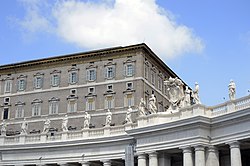Apostolic Palace
| Palazzo Apostolico | |
|---|---|
| Official residence of the Pope | |

A view of the Papal Apartments from Saint Peter's Square
|
|
|
Location on a map of Vatican City
|
|
| Alternative names |
|
| General information | |
| Type | Official residence |
| Country | Vatican City |
| Coordinates | 41°54′13″N 012°27′23″E / 41.90361°N 12.45639°ECoordinates: 41°54′13″N 012°27′23″E / 41.90361°N 12.45639°E |
| Construction started | 30 April 1589 |
| Owner | The Pope |
The Apostolic Palace (Latin: Palatium Apostolicum; Italian: Palazzo Apostolico) is the official residence of the Pope, which is located in Vatican City. It is also known as the Papal Palace, Palace of the Vatican and Vatican Palace. The Vatican itself refers to the building as the Palace of Sixtus V in honor of Pope Sixtus V.
The building contains the Papal Apartments, various offices of the Catholic Church and the Holy See, private and public chapels, Vatican Museums, and the Vatican Library, including the Sistine Chapel, Raphael Rooms, and Borgia Apartment. The modern tourist can see these last and other parts of the palace, but other parts, such as the Sala Regia and Cappella Paolina, are closed to tourists. The Scala Regia can be seen into from one end but not entered.
In the fifth century, Pope Symmachus built a papal palace close to the Old St. Peter's Basilica which served an alternative residence to the Lateran Palace. The construction of a second fortified palace was sponsored by Pope Eugene III and extensively modified under Pope Innocent III in the twelfth century.
Upon returning to Rome in 1377 after the interlude of the Avignon Papacy, which saw Rome subject to civil unrest and the abandonment of several Christian monuments, the popes chose to reside first at Basilica di Santa Maria in Trastevere and then at Basilica di Santa Maria Maggiore. The Vatican Palace had fallen into disrepair from lack of upkeep and the Lateran Palace underwent two destructive fires, in 1307 and 1361, which did irreparable harm. In 1447, Pope Nicholas V razed the ancient fortified palace of Eugene III to erect a new building, the current Apostolic Palace.
...
Wikipedia

